


In the rapidly evolving landscape of medical device regulation, the De Novo pathway stands as a critical mechanism for facilitating the entry of low to moderate risk devices that lack a legally marketed predicate. This pathway not only accelerates the introduction of innovative technologies into the market but also ensures that these novel devices meet stringent safety and efficacy standards. By understanding the De Novo process, including its eligibility criteria, key differences from the 510(k) pathway, and the comprehensive steps involved in preparing a request, stakeholders can better navigate this regulatory route.
Moreover, strategic planning and adherence to FDA protocols are essential for overcoming challenges and leveraging the benefits of the De Novo pathway, ultimately advancing patient care and healthcare outcomes.
The new route is a crucial FDA procedure specifically created for medical products categorized as low to moderate risk that do not have a legally marketed reference product. This route is crucial for bringing innovative technologies to market more swiftly, fostering advancements in healthcare. The new process enables the introduction of innovative products that provide substantial advantages to patients and healthcare providers by offering a simplified pathway for marketing approval.
For instance, consider a new heart monitor embedded in a smartwatch designed to detect irregular heart rhythms. Through the new route, such a product can be assessed and authorized based on its distinctive characteristics and intended application, even without a comparable item previously available. This approach allows developers to leverage real-world data to refine and expand the applications over time, ensuring continuous improvement and compliance with evolving regulatory standards.
Furthermore, the new route is essential when fresh risks linked to advancing technologies emerge, requiring a customized regulatory strategy. For instance, Medtronic, a prominent worldwide healthcare technology firm, has effectively employed the new process to launch groundbreaking medical tools that tackle intricate health issues, thus revolutionizing patient care and results. Such cases illustrate the route's role in enabling groundbreaking medical solutions while maintaining rigorous safety and efficacy standards.
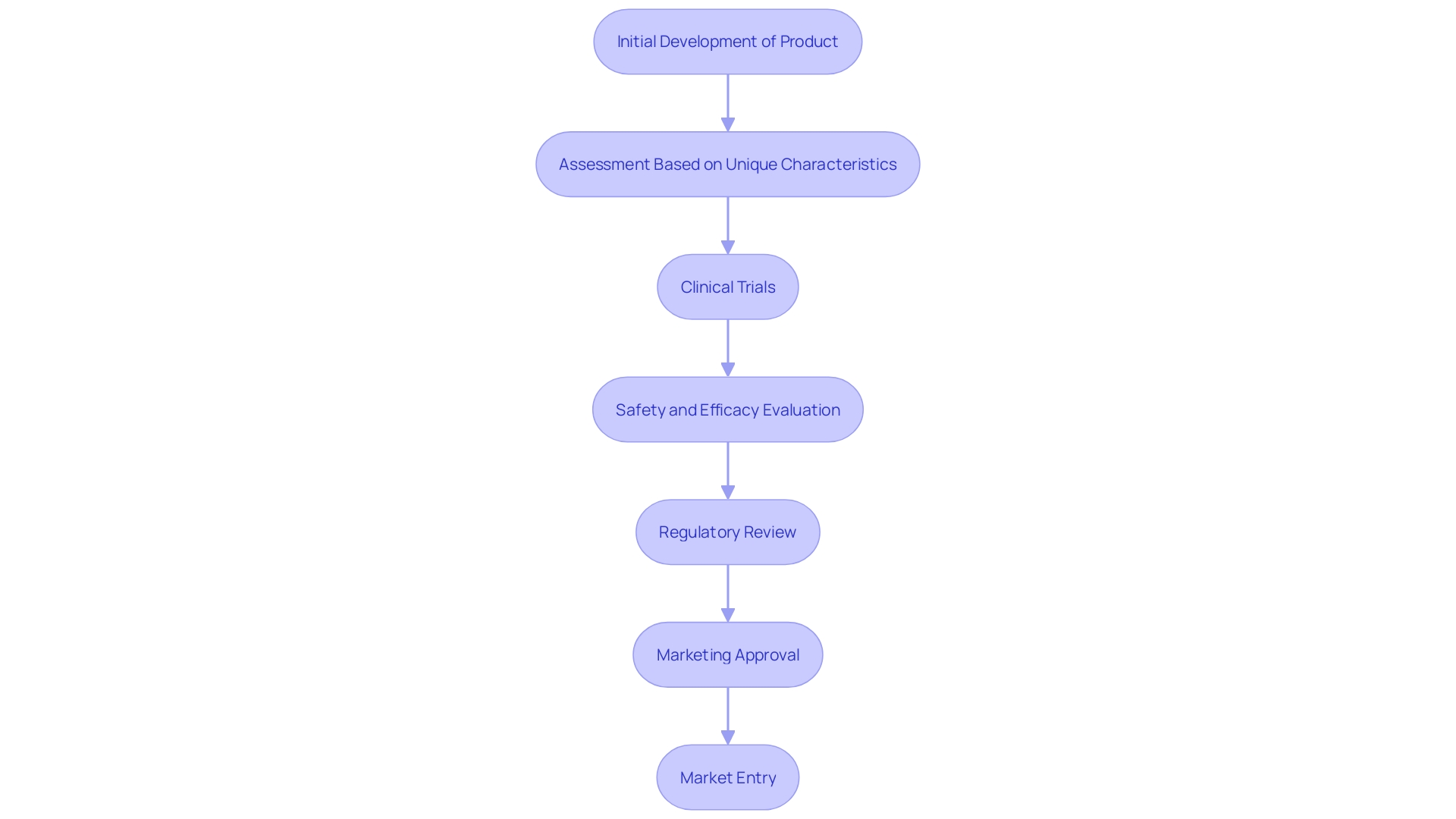
To qualify for the De Novo route, a medical instrument must satisfy particular eligibility standards, including being intended for use in humans and not being significantly similar to any existing instrument. This pathway primarily targets innovations that offer novel technological characteristics or serve previously unmet medical needs. The equipment must show safety and effectiveness through rigorous testing, supported by comprehensive data. Applicants must submit a comprehensive account of the equipment, including its intended use, technological features, and the data supporting its safety and effectiveness. For instance, the FDA's guidelines specify that Software as a Medical Device (SaMD) must meet specific criteria to be classified appropriately, reflecting a broader regulatory landscape aimed at ensuring public health and safety. Moreover, the FDA's modernization initiatives, such as the September 2023 draft guidance on best practices for selecting a predicate in 510(k) submissions, underscore the ongoing efforts to enhance review processes and ensure the robustness of clinical evaluations. This comprehensive approach ensures that new medical instruments entering the market are both safe and effective, addressing the evolving needs of patients and healthcare providers.
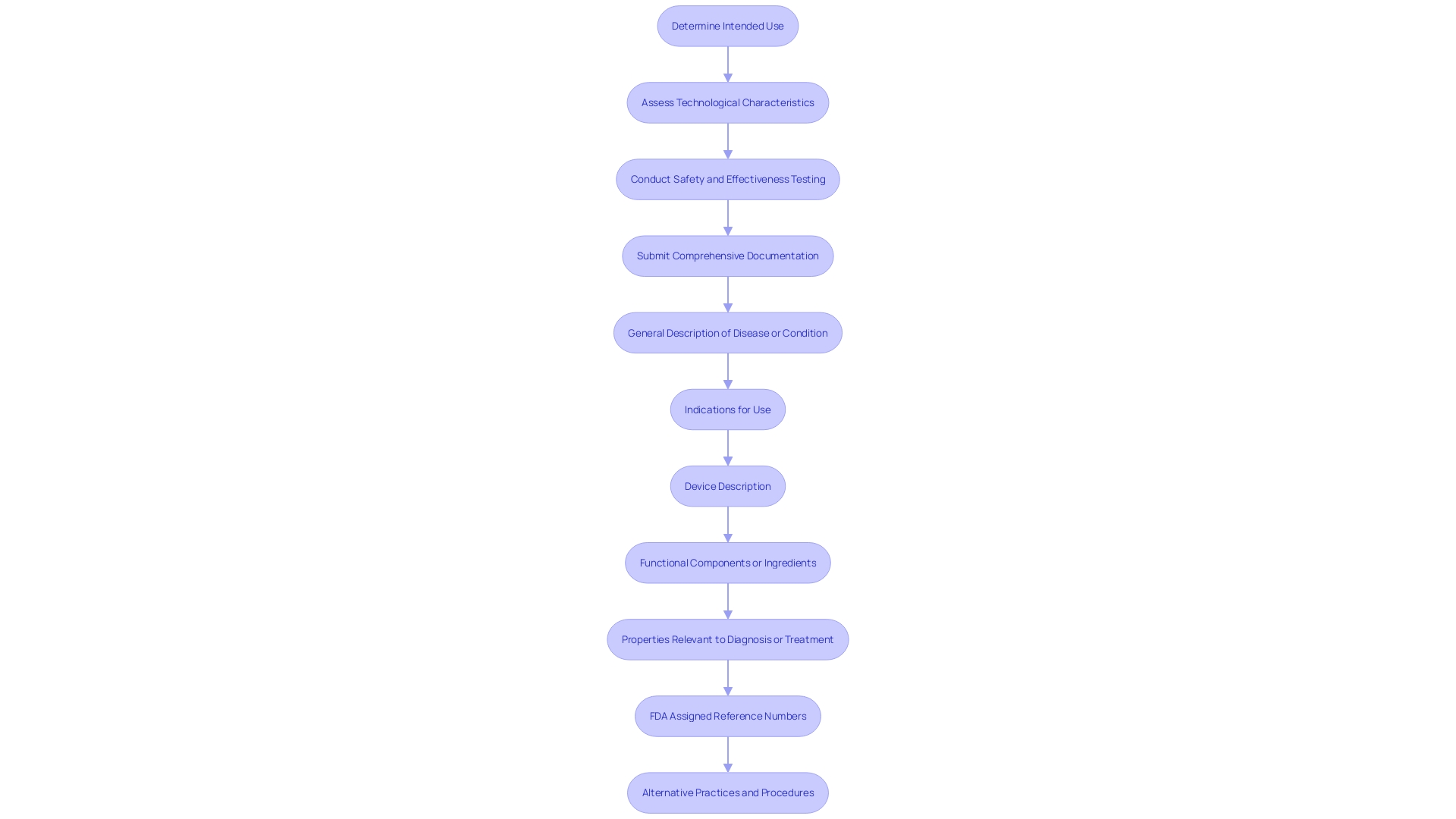
'The new and 510(k) routes fulfill different functions in the FDA's regulatory structure for medical products.'. The 510(k) route is intended for products that can show significant similarity to a currently authorized, commercially available item, frequently shortening the duration and information required for market access. In contrast, the new process is designed for innovative products that lack a predicate and thus cannot follow the 510(k) path.
The De Novo process typically demands more comprehensive data to establish the safety and effectiveness of the product. This is because these products are new to the market and lack historical data from similar items. For instance, a general description of the apparatus, including its intended use, patient population, and functional components, must be provided to the FDA. Additionally, the equipment must be shown to meet the necessary safety standards through rigorous testing and evaluation.
The regulatory load for the new approach is greater, indicating the necessity for comprehensive evaluation of innovative technologies. This process involves detailed engineering drawings, specifications, and often, alternative practices or procedures that could serve a similar purpose. The FDA's role in this comprehensive evaluation ensures that the new instrument will not pose unnecessary risks to patient health.
In summary, while the 510(k) pathway utilizes existing data and predicates to ease market entry, the alternative pathway is crucial for introducing new and innovative medical products to the market, ensuring they meet the rigorous safety and effectiveness standards established by the FDA.
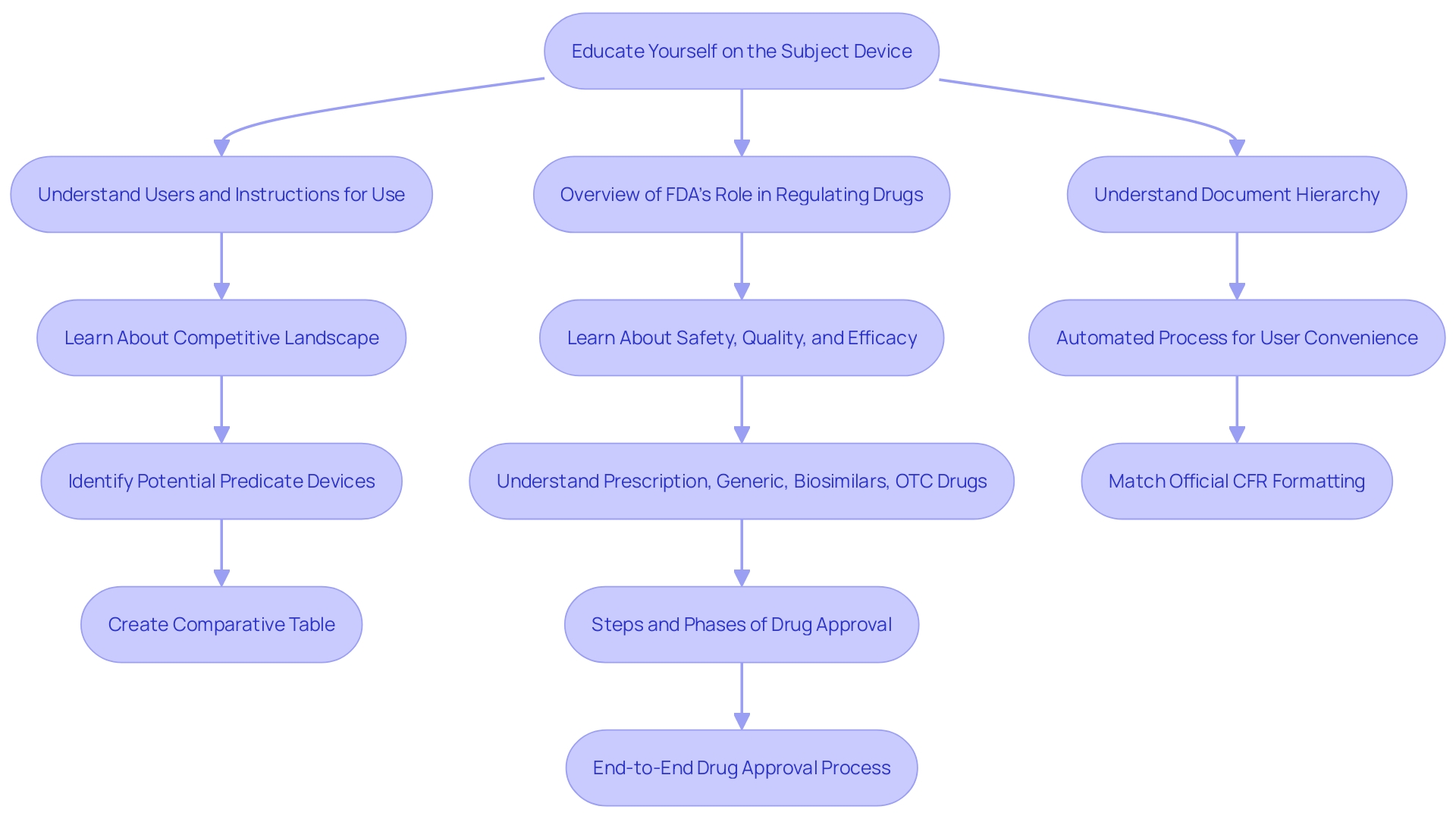
Preparing a De Novo request involves several critical steps aimed at ensuring the product’s compliance with FDA standards. Manufacturers must first undertake thorough preclinical and clinical testing to collect comprehensive data on the product's safety and effectiveness. This phase is crucial as it lays the groundwork for the subsequent stages of the process.
Next, manufacturers should compile a detailed submission package. This package must include a precise description of the apparatus, intended use, labeling, and all pertinent clinical data. 'The inclusion of these elements is fundamental, as each piece of information plays a pivotal role in the FDA's assessment of the product.'.
Engaging with the FDA early on through a pre-submission meeting is highly advisable. This step allows manufacturers to clarify expectations and address potential concerns, facilitating a smoother review process. According to the FDA’s recent efforts to modernize the 510(k) process, such engagements can significantly enhance the efficiency and effectiveness of the review process. The FDA has been actively working on developing best practices for selecting predicates to support submissions, as highlighted in the draft guidance document released on September 7, 2023. By utilizing these best practices, manufacturers can better navigate the complexities of the new pathway.
Moreover, ongoing communication with the FDA ensures that manufacturers remain aligned with regulatory expectations, thereby minimizing the risk of delays or rejections. This proactive approach is essential for successfully bringing innovative medical products to market.
Once a De Novo request is submitted, the FDA initiates a comprehensive review process. This involves scrutinizing the submitted data for safety and effectiveness and evaluating the labeling and proposed use of the apparatus. The review schedule, intended to be finished within 120 days, can differ depending on the intricacy of the product and the thoroughness of the provided information.
Manufacturers may be asked to provide additional information or clarifications during this period. The FDA's thorough approach ensures that the product meets all necessary safety and effectiveness standards before approval. The process involves evaluating different methods and protocols that are presently employed for diagnosing, treating, preventing, or alleviating the condition the tool is meant for. This rigorous evaluation process is part of the FDA's broader mandate to protect public health by ensuring the safety, effectiveness, and security of medical equipment.
Successfully navigating the De Novo route requires strategic planning and adherence to FDA protocols. Early and proactive communication with the FDA is crucial to clarify regulatory expectations and streamline the application process. "It's essential for manufacturers to conduct comprehensive clinical studies that meet FDA standards, ensuring that the safety and efficacy of the medical product are thoroughly demonstrated.". Additionally, maintaining meticulous documentation throughout the development process can significantly ease interactions with regulatory reviewers, facilitating a smoother approval process.
Grasping the regulatory environment and being aware of the necessary classifications and routes are essential. 'The FDA categorizes medical equipment into three classes based on patient risk, and this classification dictates the appropriate registration pathway—whether it's Premarket Notification (510(k)), Pre-Market Approval (PMA), or the De Novo process.'. Before an item can be marketed in the U.S., it must be FDA Cleared, Approved, or Granted through these pathways.
Moreover, familiarizing yourself with the FDA’s regulations and guidance documents is vital. This includes the investigational apparatus exemption (IDE), which is required for pre-market studies to collect safety and effectiveness data. Comprehensive understanding of the intended use, patient population, and competitive landscape of the apparatus, as well as its components and specifications, will further support a robust application.
The importance of a well-documented and comprehensive approach cannot be overstated. 'As exemplified by companies like Medtronic, which has a global team delivering innovative healthcare solutions, a rigorous and detailed strategy in regulatory compliance is fundamental to achieving successful product approval and ultimately improving patient outcomes.'.
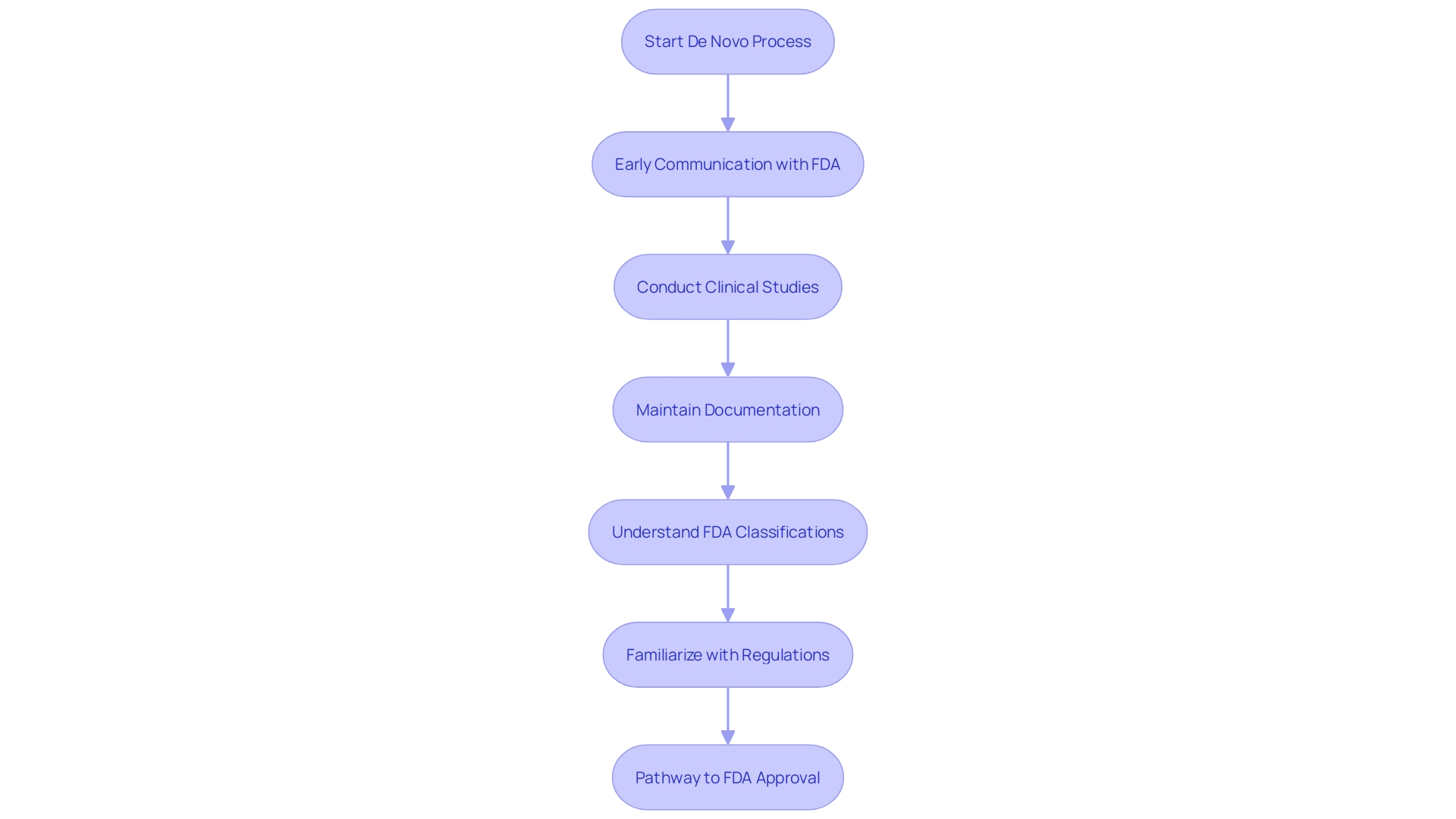
'The new pathway offers many benefits for medical product manufacturers, particularly providing a faster path to market for innovative products lacking a prior equivalent.'. This expedited process can result in the formal classification of the device, thereby enhancing the predictability of future regulatory submissions. Furthermore, successful new applications may significantly enhance patient access to groundbreaking therapies, aligning with broader social goals of advancing human health. For instance, Medtronic, a global leader in healthcare technology, has utilized such routes to introduce novel therapies that transform lives every second. By offering a structured and predictable regulatory framework, the new route not only encourages innovation but also guarantees adherence to important ethical, legal, and social factors.
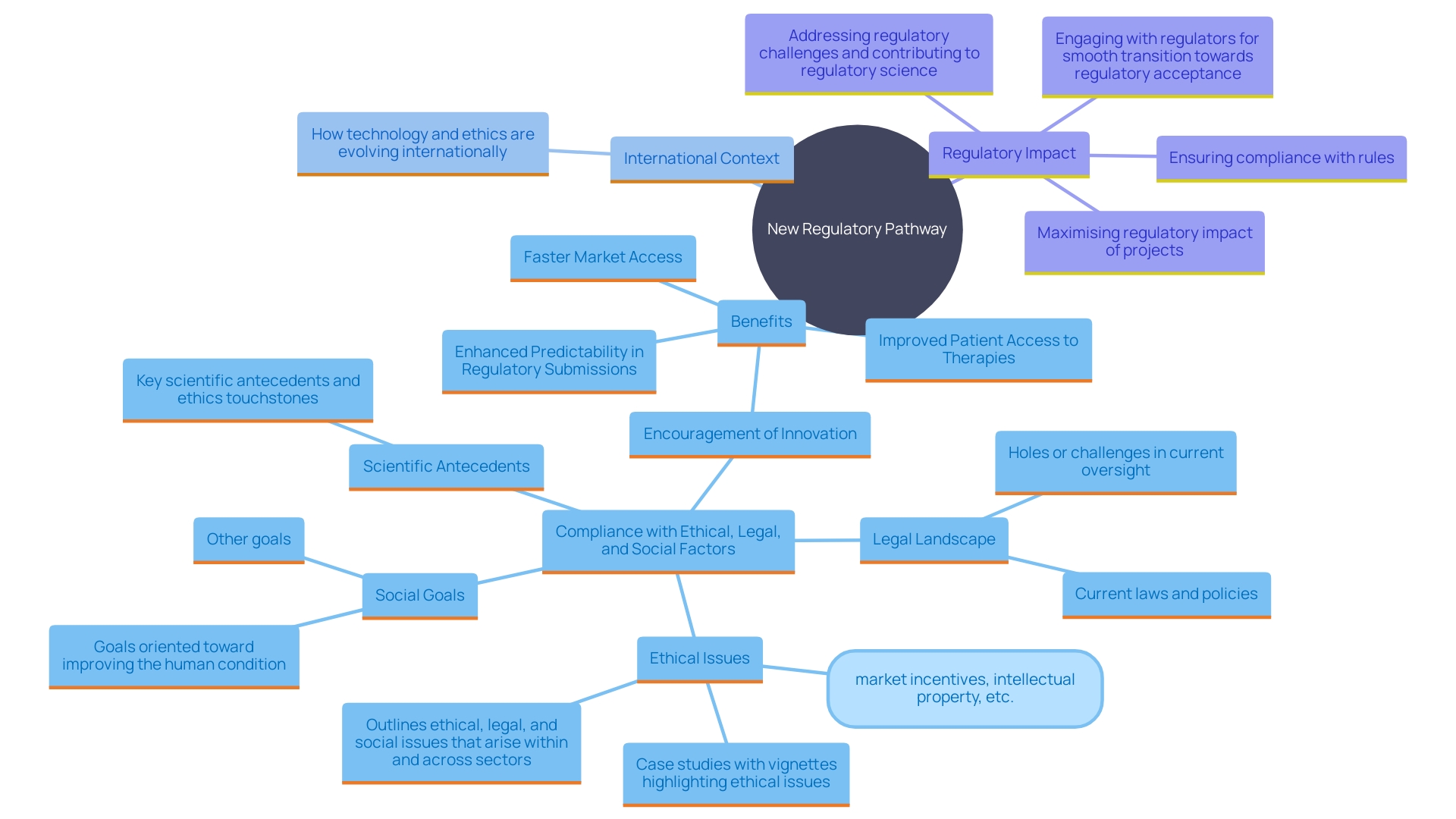
Navigating the De Novo pathway involves several challenges, primarily due to the necessity for comprehensive data to demonstrate safety and effectiveness. Manufacturers often face difficulties in designing clinical trials that meet rigorous regulatory expectations. Furthermore, the changing characteristics of technology and equipment designs can further complicate the classification process.
The worldwide aspect of the medical equipment industry presents additional hurdles. For instance, gaining market approval for new products and ensuring compliance with regulatory bodies were identified as top priorities in a recent study, with 40% and 47% of medical device leaders, respectively, highlighting these tasks as increasingly difficult due to tougher legislation and the growing volume of literature to review.
Ethical, legal, and social issues also play a significant role in the new pathway. These issues arise within and across sectors, shaped by factors such as market incentives and intellectual property. Each case study in this context often begins with vignettes to highlight specific ethical concerns, which are then analyzed through guiding questions.
Moreover, the landscape of regulatory demands is continually evolving. Survey respondents have emphasized the importance of improving efficiency in regulatory and safety document preparation to meet these demands. This includes addressing complexities in packaging and labeling while maintaining product integrity.
Being aware of these multifaceted challenges and preparing accordingly can significantly improve the chances of a successful De Novo application. Practical approaches to adapt and thrive amidst these changing regulatory landscapes are crucial for compliance and efficiency in the medical device sector.
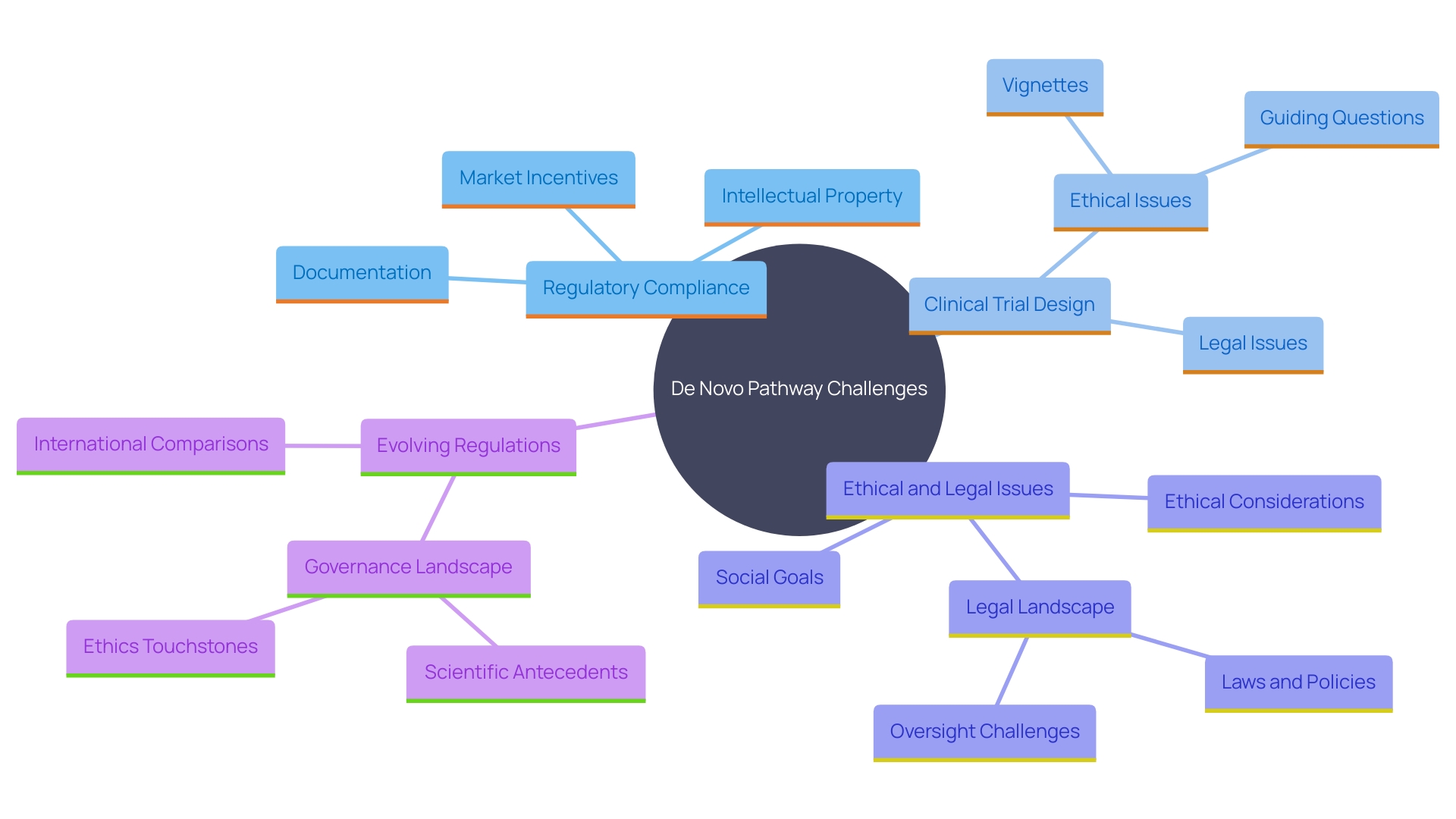
The De Novo pathway represents a vital mechanism within the FDA's regulatory framework, facilitating the introduction of low to moderate risk medical devices that lack a legally marketed predicate. This pathway not only accelerates the market entry of innovative technologies but also ensures that these devices meet rigorous safety and efficacy standards. By understanding the eligibility criteria, key differences from the 510(k) pathway, and the steps involved in preparing a De Novo request, stakeholders can navigate this process more effectively, ultimately enhancing patient care and healthcare outcomes.
Significant distinctions between the De Novo and 510(k) pathways highlight the unique role that the De Novo process plays in regulating novel devices. While the 510(k) pathway leverages existing data to streamline market entry, the De Novo pathway requires comprehensive data to establish the safety and effectiveness of new technologies. This thorough evaluation process is essential for maintaining public health and ensuring that innovative devices are introduced responsibly.
Successful navigation of the De Novo pathway necessitates strategic planning, proactive communication with the FDA, and adherence to regulatory protocols. By conducting comprehensive clinical studies and maintaining meticulous documentation, manufacturers can enhance their chances of approval. The benefits of this pathway are considerable, including expedited access to groundbreaking therapies for patients and a structured regulatory framework that supports ongoing innovation in the medical device industry.
In summary, while challenges exist within the De Novo pathway, understanding its intricacies and preparing accordingly can significantly improve the likelihood of successful applications. The ongoing evolution of technology and regulatory demands underscores the importance of adaptability and thorough preparation in bringing innovative medical devices to market.
What is the new FDA route for medical products?
The new FDA route is a regulatory pathway designed for low to moderate risk medical products that do not have a legally marketed reference product. It aims to expedite the introduction of innovative technologies to the market, enhancing advancements in healthcare.
Who can benefit from the new route?
Developers of medical products that offer substantial advantages to patients and healthcare providers can benefit from this route. It allows them to market products without needing a comparable existing product.
Can you give an example of a product that might use this new route?
An example is a smartwatch with a heart monitor designed to detect irregular heart rhythms. Such a product can be assessed based on its unique features and intended use, without needing a similar existing item.
What are the eligibility criteria for the De Novo route?
To qualify for the De Novo route, a medical instrument must: be intended for human use, not be significantly similar to any existing instrument, and show safety and effectiveness through rigorous testing.
What is the difference between the new route and the 510(k) route?
The 510(k) route is for products that can demonstrate significant similarity to an already authorized product, often requiring less data. In contrast, the new route is meant for innovative products without a predicate, requiring more extensive data to establish safety and effectiveness.
What steps are involved in preparing a De Novo request?
Preparing a De Novo request involves: conducting thorough preclinical and clinical testing, compiling a detailed submission package that includes the product description, intended use, labeling, and clinical data, and engaging with the FDA early through pre-submission meetings for clarification on expectations.
How long does the FDA review process take?
The FDA aims to complete the review process within 120 days after a De Novo request is submitted, but this timeframe may vary based on the product's complexity and the completeness of the information provided.
What challenges do manufacturers face when navigating the De Novo pathway?
Manufacturers may encounter challenges such as the need for comprehensive data to demonstrate safety and effectiveness, designing clinical trials that meet regulatory expectations, and adapting to the evolving regulatory landscape and addressing ethical, legal, and social issues.
What are the benefits of the new route for medical product manufacturers?
The new route offers several benefits, including a faster path to market for innovative products, enhanced predictability for future regulatory submissions, and improved patient access to groundbreaking therapies.
What role does ongoing communication with the FDA play in the process?
Ongoing communication with the FDA is crucial for ensuring compliance with regulatory expectations, minimizing the risk of delays or rejections, and facilitating a smoother approval process for innovative medical products.